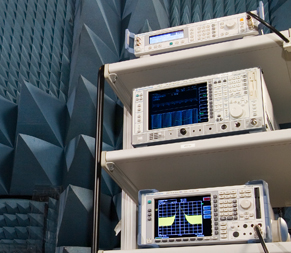Electromagnetic Compatibility (EMC) tests are a must for CE marking of electrical products. This requirement is prescribed by EMC Directive 2004 / 108 / EC, which is still up to date. However, some amendments were made to the EMC Regulation and the new EMC Regulation 2014 / 30 / EU was published in the Official Journal of the European Union.
Related regulations, Turkey is also mandatory for the member countries, including the Economic Commission for Europe. This obligation is provided by the Ministry of Industry in our country and the regulation is translated into Turkish by the Ministry of Industry and published in the Official Gazette. According to the new EMC Regulation, the product is first subjected to diffusion and immunity tests in accordance with the relevant harmonized standards. Afterwards, technical file is prepared according to other regulations (eg LVD Regulation), if any. Finally, the Declaration of Conformity must be prepared and the CE marking shall be placed on the product in the dimensions and manner specified in the regulation.
The purpose of this Regulation is to regulate the electromagnetic compatibility of the equipment and to ensure the functioning of the internal market to comply with an adequate level of electromagnetic compatibility of the equipment.
- The contents of the technical dossier must include:
- A general description and description of the product
- Drawings showing product specifications
- Technical drawings and explanations for the operation of the product
- List of harmonized test standards applied
- Test reports
The manufacturer shall maintain the technical file and declaration of conformity for the year 10 from the date of placing the product on the market. In case of nonconformity and nonconformity of the product, the producer may be warned and fined, the products may be collected from the market, sale may be prohibited or other sanctions may be required by the Ministry.
Possible nonconformities in the new EMC Regulation are listed below:
- Failure to use the CE marking as described in the regulation,
- No CE marking,
- Lack of Declaration of Conformity,
- Incomplete or incorrect preparation of the Declaration of Conformity,
- Technical File is missing or not prepared at all,
- Lack or missing manufacturer's full address on the product, package or product document.
Producers are required to fully comply with the above-mentioned requirements to avoid such non-conformities. Thus, the product will ensure compliance with the New EMC Regulation and the requirements of CE marking will be fulfilled. It is an important technical issue to know the EMC test standards and limits that should be applied specific to the product.
April 20 2016 in English published by the EU regulations (2014 / 30 / EU) in Turkey from the 2 2016 October 2014 / 30 / was harmonized in the EU.
ELECTROMAGNETIC COMPLIANCE REGULATION (2014 / 30 / EU)
Goal
ARTICLE 1 - (1) The purpose of this Regulation is to regulate the electromagnetic compatibility of the equipment and to ensure the functioning of the equipment in such a way that the equipment complies with an adequate level of electromagnetic compatibility.
Scope
ARTICLE 2 - (1) This Regulation covers the equipment defined in Article 5.
(2) This Regulation;
- 24 / 3 / 2007 dated and published in the Official Gazette No. 26472 Radio and Telecommunication Terminal Equipment Regulations,
- All kinds of instruments, indicators, equipment used or intended to be used or operated in flight, including aircraft, engines, propellers and communication devices,
- mechanism, parts, equipment, hardware or software, and equipment that is part of the hull, engine or propeller or used for maneuvering the aircraft on the ground,
- Radio equipment used by amateur radio operators provided that they are not on the market, (All components to be installed by amateur radio operators, commercial equipment modified by amateur radio operators and modified for use by these amateurs shall not be accepted as commercially available equipment.)
- Equipment not capable of generating or contributing to electromagnetic emissions exceeding the level enabling radio and telecommunications equipment and other equipment to function as intended,
- Equipment operating without unacceptable loss of performance as a result of electromagnetic disturbance resulting from normal use,
- Evaluation kits exclusively produced for professionals for research purposes only in research and development facilities,
It does not cover.
(3) In the event that the basic requirements set out in Annex-I of the equipment referred to in the first paragraph are fully or partially regulated in other European Union legislation, this Regulation shall not apply or the application of this Regulation shall not be applied as of the date of entry into force of such legislation.

